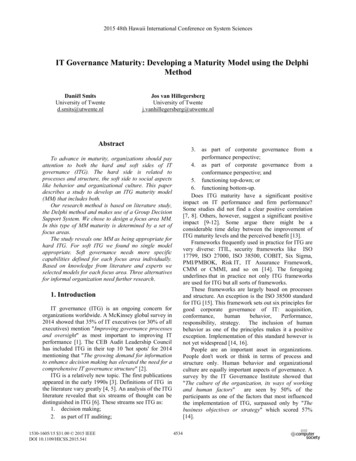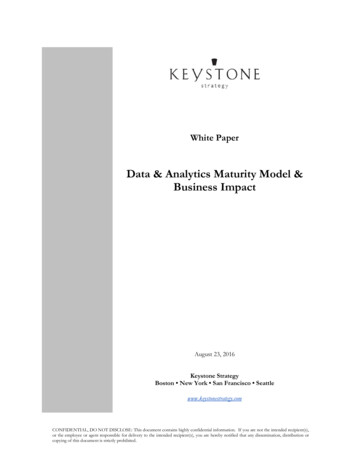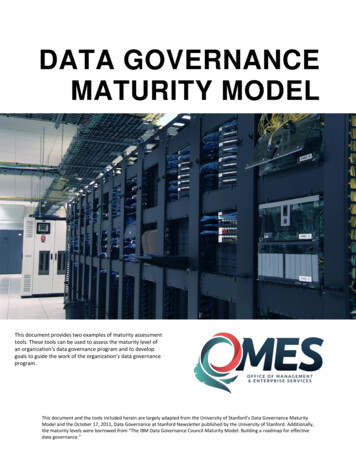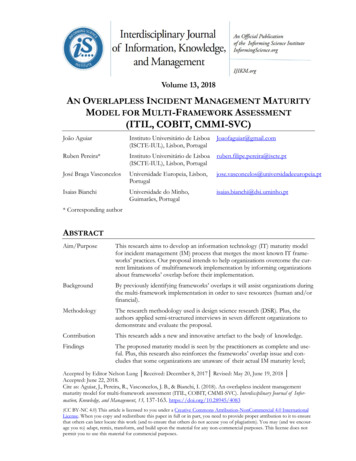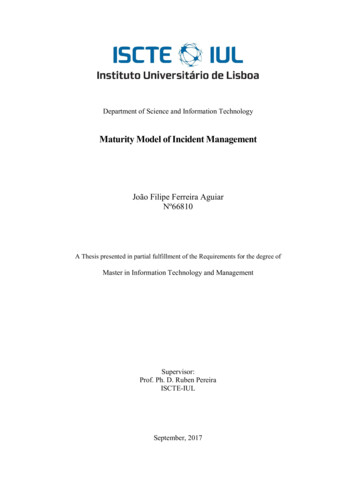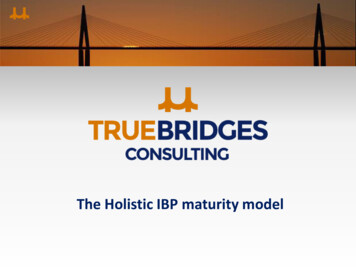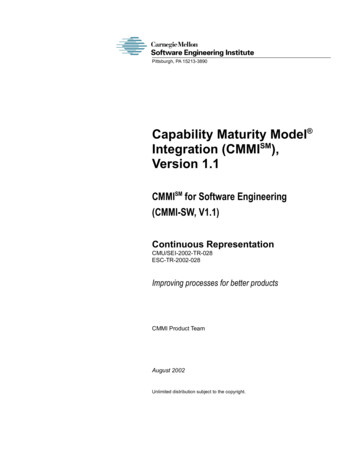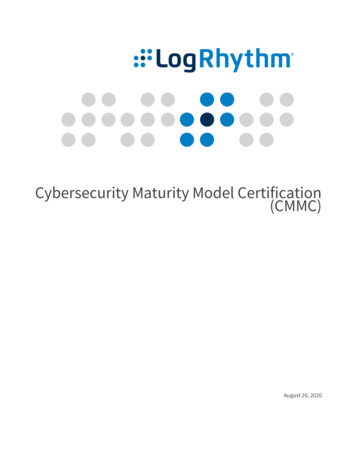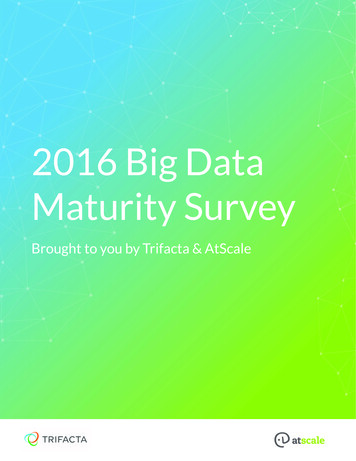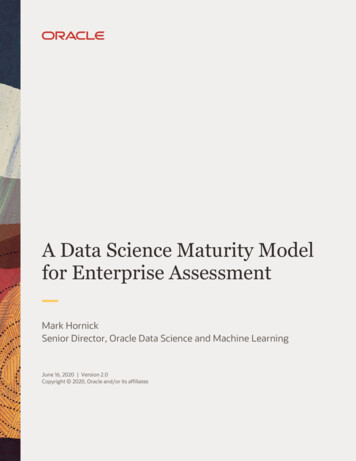
Transcription
A Data Science Maturity Modelfor Enterprise AssessmentMark HornickSenior Director, Oracle Data Science and Machine LearningJune 16, 2020 Version 2.0Copyright 2020, Oracle and/or its affiliates
PURPOSE STATEMENTThis document is an update to the Data Science Maturity Model for Enterprise Assessment introduced in 2018. As anassessment tool, this Data Science Maturity Model provides a set of dimensions relevant to data science with five maturitylevels in each—1 being the least mature, 5 being the most. Enterprises that increase their data science maturity are morelikely to increase the value they derive from data science projects.1WHITE PAPER A Data Science Maturity Model for Enterprise Assessment Version 2.0Copyright 2020, Oracle and/or its affiliates
TABLE OF CONTENTSPurpose n6Methodology8Data Awareness9Data Access11Scalability13Asset Management14Deployment17Summary Table192WHITE PAPER A Data Science Maturity Model for Enterprise Assessment Version 2.0Copyright 2020, Oracle and/or its affiliates
INTRODUCTION"Maturity models" aid enterprises in understanding their current and target states. Enterprises that already embrace datascience as a core competency, as well as those just getting started, often seek a roadmap for improving that competency. Adata science maturity model is one way of assessing an enterprise and guiding the quest for data science nirvana. Upping anenterprise’s level of data science maturity enables extracting greater value from data for making better data-drivendecisions, realizing business objectives more efficiently, and having a more agile response to changing market conditions.As an assessment tool, this Data Science Maturity Model provides a set of dimensions relevant to data science with fivematurity levels in each—1 being the least mature, 5 being the most. Here are important maturity model dimensions with thegoal to provide both an assessment tool and potential roadmap: Strategy—What is the enterprise business strategy for data science?Roles—What roles are defined and developed within the enterprise to support data science activities?Collaboration—How do data scientists collaborate with others in the enterprise to evolve and hand off data sciencework products?Methodology—What is the enterprise approach or methodology to data science projects?Data Awareness—How easily can data scientists learn about enterprise data resources?Data Access—How do data analysts and data scientists request and access data? How is data accessed, controlled,managed, and monitored?Scalability—How well do the tools used for data science scale and perform for data exploration, preparation,modeling, scoring, deployment, and collaboration?Asset Management—How are data science assets managed and controlled?Tools—What tools, including open source, are used within the enterprise for data science objectives?Deployment—How easily can data science work products be placed into production to meet timely businessobjectives?In this white paper, we discuss each of these dimensions and levels by which business leaders and data science teams canassess where their enterprise is, identify where they would like to be, and consider how important each dimension is for thebusiness and overall corporate strategy. Such introspection is a step toward identifying architectures, tools, and practicesthat can help achieve data science goals.3WHITE PAPER A Data Science Maturity Model for Enterprise Assessment Version 2.0Copyright 2020, Oracle and/or its affiliates
STRATEGYWhat is the enterprise business strategy for data science?A strategy can be defined as "a high-level plan to achieve one or more goals under conditions of uncertainty." With respectto data science, goals may include making better business decisions, making new discoveries, improving customeracquisition/retention/satisfaction, reducing costs, optimizing processes, and more. Depending on the quantity and qualityof data available and the way that data is being used, the degree of uncertainty facing an enterprise can be significantlyreduced or accentuated. Strategy, however, can sometimes be an abstract idea. Some strategy statements might include: “Ensure single version of the truth with enterprise data”“Strive to have enterprise decisions backed by data analytics”“Leverage AI to stay competitive, increase revenue and profits”“Build data science teams and develop skills in-house”“Democratize machine learning across the enterprise”The five levels of the strategy dimension are:Level 1: Enterprise has no (consistent) governing strategy for applying data science.For enterprises at Level 1, the world of data science may be unfamiliar, but data certainly is not. Data analytics may be aroutine part of enterprise activity but with no overall governing strategy or realization that data is a valuable corporate asset.The enterprise has defined goals, but the extent to which data supports those goals is limited.Level 2: Enterprise is exploring the value of data science as a core competency.The Level 2 enterprise realizes the potential value of data and the need to leverage that data for greater business advantage.With all the hype and substance around machine learning (ML) and artificial intelligence (AI), business leaders areinvestigating the value data science can offer and are actively conducting proofs-of-concept—exploring data scienceseriously as a core business competency.Level 3: Enterprise recognizes data science as a core competency for competitive advantage.Having done due diligence, enterprises at Level 3 have committed to pursuing data science as a core competency and thebenefits it can bring. Systematic efforts are underway to enhance data science capabilities along the remaining dimensionsof this maturity model.Level 4: Enterprise embraces a data-driven approach to decision-making.Once an enterprise establishes a competency in data science, enterprises at Level 4 feel confident to embrace the use ofdata-driven decision-making—backing up or substituting business instincts with measured results and machine learning. Asdata and skill sets are refined, business leaders have greater confidence to trust data science results when making keybusiness decisions.4WHITE PAPER A Data Science Maturity Model for Enterprise Assessment Version 2.0Copyright 2020, Oracle and/or its affiliates
Level 5: Data is treated as an essential corporate asset—data capital.A capping strategy with respect to data science involves giving data the "reverence" it deserves, recognizing it as a valuablecorporate asset and a form of capital. At Level 5, the enterprise allocates adequate resources to conduct data scienceprojects supported by proper management, maintenance, assessment, security, and growth of data assets, and the humanresources to systematically achieve strategic goals.ROLESWhat roles are defined and developed in the enterprise to support data science activities?A role can be defined as "a set of connected behaviors, rights, obligations, beliefs, and norms as conceptualized by people ina social situation." Data science within an enterprise can benefit from the introduction of new roles. There are several rolesthat have become more common in recent years, and they are worth considering if not found in your enterprise: datascientist, chief data officer, chief data science officer, data librarian. The Big Data Executive Survey 2018 notes that 62.5percent of senior Fortune 1000 business and technology decision-makers stated their organization had appointed a CDO,which reflects the recognized importance of such roles.What do the people in these roles do? A Chief Data Officer will typically oversee data-related functions such as managingwhat and how data is stored and for what purposes. A CDO has charge over ensuring data quality, governance, and masterdata management. CDOs will likely also set data strategy for data-driven decision-making with a business focus and overseedata analysts. A CDO is sometimes referred to as a Chief Analytics Officer. This is in contrast to a Chief (Digital) InformationOfficer, who may focus more on managing corporate IT strategy and computer systems supporting the enterprise.A Chief Data Scientist, or Chief Data Science Officer, sets the hiring and skill set needs and development of the data scienceteam, and may serve as a coach for junior and senior data scientists as a hands-on leader. The CDS is often the finaldecision-maker on data science projects involving the methodology and algorithms that should be applied, and evaluatingthe results achieved. The CDS presents data science project results to other CXOs as well as customers and clients.Data librarians are increasingly becoming valuable resources for managing and curating data—further enabling its use andvalue. Data librarians may help guide the evolution of data libraries, archives, and repositories, while establishinginstitutional data management policy and infrastructure in coordination with the data science C-level executives.Once considered unicorns, data scientists are now more numerous as universities offer degrees at both the masters anddoctorate level. Even so, data scientists may have different strengths, ranging from their ability to prepare/wrangle data,write code, use machine learning algorithms, effectively use visualization, and communicate results to both technical andnontechnical audiences. As such, a given data science project may require a team of data scientists with complementaryskills.5WHITE PAPER A Data Science Maturity Model for Enterprise Assessment Version 2.0Copyright 2020, Oracle and/or its affiliates
The five maturity levels of the roles dimension are:Level 1: Traditional data analysts explore and summarize data using deductive techniques.Enterprises at Level 1 may have people dedicated to data analysis—data analysts—and draw on skills of databaseadministrators (DBAs) or business analysts to deliver business intelligence. They likely use a variety of tools that support, forexample, spreadsheet analytics, visualization, dashboards, database query languages, among others. People in these rolestypically use deductive reasoning in the sense that they formulate queries to answer specific questions.Level 2: “Data scientist” role is introduced to begin leveraging machine learning and other advanced techniques.The Level 2 enterprise recognizes the need for more sophisticated analytics and the value that those trained in datascience—the now much-admired role of the data scientist—can bring to the enterprise. Level 2 enterprises can now moreconfidently explore, develop, and deploy solutions based on ML or AI. At Level 2, data scientists are typically added toindividual departments or organizations as needed.Level 3: Chief Data Officer (CDO) role is introduced to help manage data as a corporate asset.Although not necessarily a pure data science role, the Chief Data Officer role is highly beneficial, if not critical, for the datascience-focused enterprise. The CDO is responsible for enterprise-wide governance and use of data assets. Along with aCDO, the role of data librarian may also be introduced to support data curation within the enterprise. With the introductionof these roles at Level 3, not only is data science being taken more seriously, but the key input to data science projects—thedata—is as well.Level 4: The data scientist career path is codified and standardized across the enterprise.Level 4 enterprises strive for greater uniformity across the enterprise for the data scientist role with respect to jobdescription, skills, and training. In some enterprises, data science activities and/or data scientists may be organized under acommon or matrix management structure.Level 5: Chief Data Science Officer (CDSO) role introduced.Just as the Chief Data Officer role is beneficial for enterprises taking data more seriously, the Level 5 enterprise alsorecognizes the need for a Chief Data Science Officer or Chief Data Scientist.COLLABORATIONHow do data scientists collaborate with others in the enterprise to evolve and hand off data science work products?Data science projects solving important business problems often involve significant collaboration, defined as "two or morepeople or organizations working together to realize or achieve a goal." Successful data science projects that positivelyimpact an enterprise will often require the involvement of multiple individuals in different roles: data scientists, data andbusiness analysts, business problem owners, domain experts, application and dashboard developers, database6WHITE PAPER A Data Science Maturity Model for Enterprise Assessment Version 2.0Copyright 2020, Oracle and/or its affiliates
administrators, data engineers, and information technology (IT) administrators, just to name a few. Collaboration can beinformal or formal; however, in this context, we look to processes, methodologies, and tools that support, encourage,monitor, and guide collaboration among team members and business leaders, especially for business problem definition.Even just among data scientists, it is important to facilitate collaboration with common data access, sharing of data sciencework products, and interactive multiperson editing capabilities.When forming a data science team, complementary skills in the area of visualization, modeling, communication, technology,data wrangling, and programming are needed across team members, where one person’s strength compensates foranother’s weakness. In the figure, our goal is to form a team that ensures we have adequate coverage in each skill area.Making it easy for members of this team to collaborate—to share or hand off intermediate results at various stages of theproject, even in real time—can greatly benefit overall team productivity and the quality of results.Forming a data science team—complementary skillsThe five maturity levels of the collaboration dimension are:Level 1: Data analysts and/or data scientists work independently, storing data and results in local environments andhanding results “over the wall.”Enterprises at Level 1 often suffer from the silo effect, where data analysts and data scientists are in different parts of theenterprise and work in isolation, focusing narrowly on the data they have access to, to answer questions for theirdepartment or organization. Results produced in one area may not be consistent with those in another, even if theunderlying question is the same. These differences may result from using (possibly subtly) different data, or versions of thesame data, or taking a different approach to arrive at a given result. These differences can result in organizationalmisalignment and make for interesting cross-organization or enterprisewide meetings, when results are presented.Level 2: Greater collaboration between “data keepers” and “data users” for finding and enhancing data.The Level 2 enterprise seeks greater collaboration among the traditional keepers of data (IT) and the various lines ofbusiness with their data analysts and data scientists. Sharing of data and results may still be ad hoc, but greatercollaboration helps identify data to solve important business problems and communicate results within the organization orenterprise.Level 3: Recognized need for greater collaboration in sharing, modifying, and handing off data science work products withindata science team.With the introduction of data scientists, and the desire to make greater use of data to solve business problems, Level 3enterprises see the need to have greater collaboration across the team involved in or affected by data science projects.These include data scientists, business analysts, business leaders, and application/dashboard developers, among others.Collaboration takes the form of sharing, modification, and hand-off of data science work products. Work products consist ofthings such as data (raw and transformed); data visualization plots and graphs; requirements and design specifications;code written as R, Python, SQL, and other scripts directly or in web-based notebooks (e.g., Zeppelin, Jupyter); and predictivemodels. Use of traditional tools such as source code control systems or object repositories with version control may be used,but inconsistently.Level 4: Tools introduced for sharing, modifying, tracking, and handing off data science work products.7WHITE PAPER A Data Science Maturity Model for Enterprise Assessment Version 2.0Copyright 2020, Oracle and/or its affiliates
Level 4 enterprises build on the progress from Level 3, introducing tools specifically geared toward enhanced collaborationamong data science team members. This includes support for sharing and modifying work products, as well as trackingchanges and the flow of work. The ability to hand off work products within a defined workflow in a seamless and controlledmanner is key. Different organizations within the enterprise may experiment with a variety of tools, which typically do notinteroperate.Level 5: Standardized tools are introduced across the enterprise to enable seamless collaboration.While the Level 4 enterprise made significant strides in enhancing collaboration, the Level 5 enterprise standardizes onprocesses, methodologies, and tools to facilitate cross-enterprise collaboration among data science team members.METHODOLOGYWhat is the enterprise approach or methodology to data science?Methodologies come in various flavors. The most often cited methodology or process for machine learning—a key elementof data science—is CRISP-DM. Other data science methodologies vary in their complexity, such as the Data Science Lifecycleor Team Data Science Process. Still others support general software development such as Agile and Scrum. Even establishedmethodologies may need to be tailored to the needs of a given enterprise, for example, adding explicit feedback loops orexpanded data awareness/access phases.The goal is to reduce project risk, increase productivity, and enhance data science project outcomes using proven as well asenterprise-tailored methodologies. Following a solid data science methodology will often lead to more accurate and robustmodels. Guidelines and recommendations specific to model development may also be codified into a methodology, wherebest practices for feature engineering, prescriptive analytics, model evaluation, and statistical and ML model experimentsare provided. A good methodology will also define the expected outputs for the various team roles.The five maturity levels of the methodology dimension are:Level 1: Data analytics is focused on business intelligence and data visualization using an ad hoc methodology.For Level 1 enterprises, data analysts and other team members typically follow no established methodology, relying insteadon their experience, skills, and preferences. The focus is on business intelligence and data visualization through dashboardsand reports, relying on traditional deductive query formulation.Level 2: Data analytics are expanded to include machine learning for solving business problems, but still using an ad hocmethodology.Like Level 1, Level 2 enterprises typically follow no established methodology, relying instead on team member experience,skills, and preferences. However, enterprises at Level 2 supplement traditional roles such as data analysts who providebusiness intelligence and data visualization, with data scientists who introduce more advanced data science techniques suchas ML. With the introduction of data scientists, there are implicit enhancements to the ad hoc data science methodology.Level 3: Individual organizations begin to define and regularly apply a data science methodology.8WHITE PAPER A Data Science Maturity Model for Enterprise Assessment Version 2.0Copyright 2020, Oracle and/or its affiliates
Level 3 enterprises are in the experimental stage where individual organizations start to define their own methodologicalpractices or leverage existing ones, such as CRISP-DM. Goals include increasing productivity, consistency, and repeatabilityof data science projects while controlling risk. Data science projects may or may not effectively track performance ofdeployed model outcomes.Level 4: Basic data science methodology best practices are established for data science projects.Level 4 enterprises build on the progress from Level 3 by establishing methodology best practices throughout theenterprise. Such best practices are derived from organizational experimentation or adopted from an existing methodology.As a result of establishing best practices, the enterprise sees increased productivity, consistency, and repeatability of datascience projects with reduced risk of failure.Level 5: Data science methodology best practices are formalized across the enterprise.Having established best practices for data science in Level 4, the Level 5 enterprise formalizes additional key aspects of datascience projects, including project planning, requirements gathering/specification, and design, as well as implementation,deployment, and project assessment.DATA AWARENESSHow easily can data scientists learn about enterprise data resources?The term awareness can be defined as "the state or condition of being aware; having knowledge; consciousness." For dataawareness, we might refine this definition as "having knowledge of the data that exists in an enterprise and anunderstanding of its contents." As the image above suggests, enterprises often have many data repositories acrossorganizations and departments. Data may reside in databases, flat files, spreadsheets, among others, across a range ofhardware, operating systems, and file systems—the data landscape—or be data in motion from streaming sources like IoTsensors. Moreover, data silos form where one part of the enterprise is unaware of the existence of data in another, let alonethe meaning of that data.9WHITE PAPER A Data Science Maturity Model for Enterprise Assessment Version 2.0Copyright 2020, Oracle and/or its affiliates
Overcoming data silos through data integration or a data catalogData awareness across an enterprise give data science team members, especially data scientists, the ability to browse andunderstand data from a metadata perspective—what Gartner refers to as “data source discovery.” Such metadata mayinclude textual descriptions of things such as tables and individual columns, key summary statistics, data quality metrics,among others. Data awareness is essential to increase productivity, but also to inventory data assets and enable anenterprise to move toward "a single version of the truth."The five maturity levels of the data awareness dimension are:Level 1: Data users unaware of broader data assets available in the enterprise.Enterprises at Level 1 are often in the dark when it comes to understanding the data resources that may exist across theenterprise. Data may be siloed in spreadsheets or flat files on employee machines or stored in departmental data marts orapplication-specific databases. No map of the data landscape exists to assist in finding data of interest; moreover, theenterprise has not prioritized this as a need.Level 2: Data analysts and data scientists seek additional data sources through "key people" contacts.The Level 2 enterprise has “awakened” to the need for and benefits of finding the right data. As data analysts and datascientists take on more analytically interesting projects, the search for data ensues on a personal level—individuallycontacting data owners or others “in the know” within the enterprise to understand what data exists and where it resides. Asignificant amount of time is lost trying to find data, interpret it, and assess its quality.Level 3: Existing enterprise data resources are cataloged and assessed for quality and utility for solving business problems.The Level 3 enterprise sees the need for making it easier for data science teams to find data and have greater confidence inits quality for solving business problems. Ad hoc metadata catalogs begin to emerge, which make it easier to understandwhat data is available. However, such catalogs are nonstandard, not integrated, and dispersed across the enterprise.Level 4: Enterprise introduces metadata management and data catalog tool(s).The Level 4 enterprise builds on the progress from Level 3 by introducing metadata management tools where data scientistsand others can discover data resources available to solve critical business problems. Since the enterprise is just starting totake metadata seriously, different departments or organizations within an enterprise may use different tools. While animprovement for data scientists, the metadata models across tools are not integrated, so multiple tools may need to beused.Level 5: Enterprise standardizes on tool(s) for data catalog/metadata management and institutionalizes its use for all dataassets.The Level 5 enterprise has fully embraced the value of integrated metadata and facilitating the maintenance andorganization of that metadata through effective tools. All data assets are curated for quality and utility with full metadatadescriptions to enable efficient data identification and discovery across the enterprise. Data science team productivity andproject quality increase as members can now easily find available enterprise data10WHITE PAPER A Data Science Maturity Model for Enterprise Assessment Version 2.0Copyright 2020, Oracle and/or its affiliates
DATA ACCESSHow do data analysts and data scientists request and access data?How is data access controlled, managed, and monitored?When we consider data access, one definition refers to "software and activities related to storing,retrieving, or acting on data housed in a database or other repository." This is normallycoupled with authorization—who is permitted to access what—and auditing—who accessedwhat, when, and from where. As discussed below, data access can be provided with little orno control such as when handing someone a memory stick, or strict access controlthrough secure database authentication and computer network authentication. Dataaccess takes into account not only the user side, but also the ability of administrators toeffectively manage the data access lifecycle—from initial request and granting privileges,to revoking privileges and post-use data cleanup. Applying encryption, obfuscation, andpermission helps ensure data privacy, increasingly required by government entities such asthe European Union’s General Data Protection Regulation (GDPR) and California ConsumerPrivacy Act (CCPA).Data lifecycleIt is important to characterize the data lifecycle when thinking about data access. In Generate and Capture, data comes intoan organization, usually through data entry, acquisition from an external source, or signal reception, such as transmitted11WHITE PAPER A Data Science Maturity Model for Enterprise Assessment Version 2.0Copyright 2020, Oracle and/or its affiliates
sensor data. In Access, Secure, and Audit, data security is managed through explicit granting and revoking of accessprivileges. It is clear who is accessing what data, when, and for what purpose. In Prepare and Maintain, data is processedthrough integration with other data, or cleansed, and goes through extract, transform, and load (ETL) or extract, load, andtransform (ELT), which likely needs to be done on an ongoing basis. In Use, this is typically where data science teams applytheir skills with ML in support of enterprise objectives. In Publish, some data may be made available to a broader audience,sometimes the public. In Archive, data is removed from all production environments and maintained for a period of timedepending on enterprise or legal requirements. In Purge and Destroy, data, which has typically been archived because it isno longer needed, is deleted.The five maturity levels of the data access dimension are:Level 1: Data typically accessed via flat files obtained from various sources.Data science teams at Level 1 enterprises use what has historically been called the sneakernet. If you need data, you walkover to the data owners, get a copy on a hard drive or memory stick, and load it onto your local machine. This, of course, hasmorphed into emailing requests to data owners and either getting back requested data via email, drop boxes, or FedEx’dmemory sticks or hard drives. Providing access to data in this manner is clearly not secure. Further, obtaining the “right”data is unlikely to occur on the first try, so multiple iterations may be needed with data custodians. This results in the datarequest cycle—yielding delays, frustration, and even annoying those data custodians.Level 2: Data access is available via direct programmatic database access.In Level 2 enterprises, the sneakernet is recognized as insecure and inefficient. Moreover, since much of enterprise data isstored in databases, authorization and programmatic access is more readily enabled. With direct access to databases viaconvenient APIs (ODBC, R, and Python packages, etc.), more data can be made available to data science teams, therebyshortening the data request cycle. However, any processing beyond what is possible in the data repository/environmentitself, e.g., SQL for relational databases, still requires data to be pulled to the client machine, which can have securityimplications.Level 3: Data scientists have authenticated, programmatic access to large volume data, but database administratorsstruggle to manage the data access lifecycle.The Level 3 enterprise is experiencing data access growing pains. Data scientists now have access to large volume data andwant to use more if not all of that data in their work. Database administrators are inundated with requests for both broad(multischema) and narrow (individual table) data access.
Jun 16, 2020 · Data science within an enterprise can benefit from the introduction of new roles. There are several roles that have become more common in recent years, and they are worth considering if not found in your enterprise: data scientist, chief data officer, chief data science officer, data librarian. The Big
